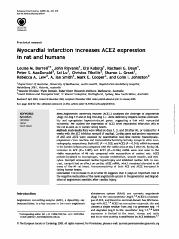Please use this identifier to cite or link to this item:
https://ahro.austin.org.au/austinjspui/handle/1/9860| Title: | Myocardial infarction increases ACE2 expression in rat and humans. | Austin Authors: | Burrell, Louise M ;Risvanis, John;Kubota, Eiji;Dean, Rachael G;MacDonald, Peter S;Lu, Sai;Tikellis, Christos;Grant, Sharon L;Lew, Rebecca A;Smith, A Ian;Cooper, Mark E;Johnston, Colin I | Affiliation: | Department of Medicine, University of Melbourne, Austin Health, Repatriation Heidelberg Hospital, Heidelberg 3081, Victoria, Australia | Issue Date: | 25-Jan-2005 | Publication information: | European Heart Journal 2005; 26(4): 369-75; discussion 322-4 | Abstract: | Angiotensin converting enzyme (ACE) 2 catalyses the cleavage of angiotensin (Ang) I to Ang 1-9 and of Ang II to Ang 1-7. ACE2 deficiency impairs cardiac contractility and upregulates hypoxia-induced genes, suggesting a link with myocardial ischaemia. We studied the expression of ACE2 after myocardial infarction (MI) in the rat as well as in human failing hearts.Rats were killed at days 1, 3, and 28 after MI, or treated for 4 weeks with the ACE inhibitor ramipril (1 mg/kg). Cardiac gene and protein expression of ACE and ACE2 were assessed by quantitative real-time reverse transcriptase-polymerase chain reaction and immunohistochemistry/activity assays/in vitro autoradiography, respectively. Both ACE (P = 0.022) and ACE2 (P = 0.015) mRNA increased in the border/infarct area compared with the viable area at day 3 after MI. By day 28, increases in ACE (P = 0.005) and ACE2 (P = 0.006) mRNA were also seen in the viable myocardium of MI rats compared with myocardium of control rats. ACE2 protein localized to macrophages, vascular endothelium, smooth muscle, and myocytes. Ramipril attenuated cardiac hypertrophy and inhibited cardiac ACE. In contrast, ramipril had no effect on cardiac ACE2 mRNA, which remained elevated in all areas of the MI rat heart. Immunoreactivity of both ACE and ACE2 increased in failing human hearts.The increase in ACE2 after MI suggests that it plays an important role in the negative modulation of the renin angiotensin system in the generation and degradation of angiotensin peptides after cardiac injury. | Gov't Doc #: | 15671045 | URI: | https://ahro.austin.org.au/austinjspui/handle/1/9860 | DOI: | 10.1093/eurheartj/ehi114 | Journal: | European heart journal | URL: | https://pubmed.ncbi.nlm.nih.gov/15671045 | Type: | Journal Article | Subjects: | Aged Angiotensin-Converting Enzyme Inhibitors.pharmacology Animals Carboxypeptidases.biosynthesis.genetics Gene Expression Regulation, Enzymologic.drug effects Humans Male Middle Aged Myocardial Infarction.enzymology Myocardium.enzymology Peptidyl-Dipeptidase A.biosynthesis.genetics RNA, Messenger.genetics Ramipril.pharmacology Rats Rats, Sprague-Dawley Renin-Angiotensin System Reverse Transcriptase Polymerase Chain Reaction.methods |
| Appears in Collections: | Journal articles |
Files in This Item:
| File | Description | Size | Format | |
|---|---|---|---|---|
| 15671045.pdf | 220.02 kB | Adobe PDF |  View/Open |
Page view(s)
62
checked on Dec 27, 2024
Download(s)
138
checked on Dec 27, 2024
Google ScholarTM
Check
Items in AHRO are protected by copyright, with all rights reserved, unless otherwise indicated.
